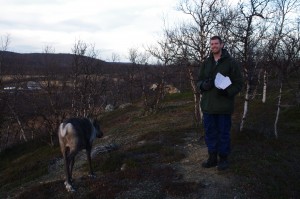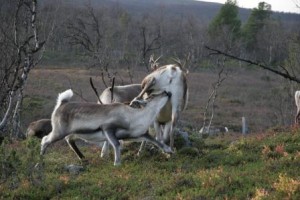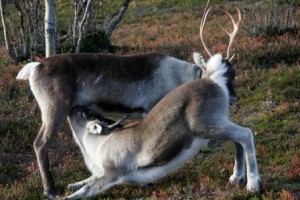 Sacha Engelhardt
Sacha Engelhardt
Ph.D. Student
Contact Information
Department of Biology
Concordia University (Loyola Campus)
7141 Sherbrooke St. W. H4B 1R6
Montreal, QC, Canada
Office: SP301.16
Lab: SP434
(514) 848-2424 (ext. 4021)
Education
2010 – Present: Biology Graduate Student at Concordia University, Montréal
2007-2010: B.Sc. Specialization in Ecology, Concordia University, Montréal
2001-2007: B.F.A. Specialization in Theatre Performance, Concordia University, Montréal
My Project
Suckling and allosuckling in reindeer (Rangifer tarandus): the evolution of sociality and cooperative breeding.
Background
The suckling of offspring from females other than their own mother is referred to as allosuckling. To study the causes and functions of allosuckling, we will observe semi-captive reindeer, Rangifer tarandus (Linnaeus 1758). We will test four hypotheses: (1); milk-theft, calves opportunistically allosuckle; (2) mismothering, misdirected maternal care; (3) benefit hypothesis, allosuckling calves benefit by increasing mass gain; and (4) compensation hypothesis, allosuckling calves compensate for nutritional and/or growth deficiencies. Allosuckling will be observed for the first 10 weeks of lactation in a group of captive reindeer, R. tarandus, composed of 25 mother-calf pairs. We will collect the frequency, duration and positions adopted during (parallel, perpendicular, and antiparallel) suckling and allosuckling bouts using the scan sampling and the ad libitum methods of data collection. The mothers and their calves will be weighed every week. We will assess the influence of mass of calves and mothers at calving, calf sex, birth order, social rank, and the age of mothers on allosuckling in reindeer.
Field work
We will be studying a reindeer population from the Kutuharju Field Reindeer Research Station in Kaamanen, Finland (69°N, 27°E). This herd is composed of semi-domestic reindeer that are free ranging for most of the year excluding the calving and rutting periods. These animals are managed and harvested by the Finnish Reindeer Herders Association, therefore, we are able to continuously gather information on the ecology and behaviour of the individual reindeer. See pictures on this web page
Objectives
- Test four allosuckling hypotheses
- Milk-theft
- Mismothering
- Benefit
- Compensation
- Further understanding of allosuckling in ungulates
Publications
- S.C. Engelhardt*, R. B. Weladji, Ø. Holand, and M. Nieminen. 2016. Allosuckling in reindeer (Rangifer tarandus): a test of the improved nutrition and compensation hypotheses. Mammalian Biology 81:146-152.
- S.C. Engelhardt*, R.B. Weladji, Ø. Holand, K.H. Røed & M. Nieminen (2014) Evidence of reciprocal allonursing in captive reindeer. Ethology 121:245-249
- S.C. Engelhardt*, R.B. Weladji, Ø. Holand, C.M. de Rioja, R.K. Ehmann & M. Nieminen (2014) Allosuckling in reindeer (Rangifer tarandus): milk-theft, mismothering or kin selection? Behavioural Processes 107:133-141
- Kalioujny, T., Weladji, R.B., Paré P., and Engelhardt, S.C. (2014) The effect of zoo visitors on activity patterns of captive African herbivores. Journal of Biodiversity Management and Forestry 2:3. DOI:10.4172/2327-4417.1000112.
- S.C. Engelhardt, Weladji, R.B., Holand, Ø., Røed, K.H., and Nieminen, M. (2014) Evidence of reciprocal allonursing in captive reindeer, Rangifer tarandus. Genomes to/aux Biomes, May 25-29, 2014, Montreal, Quebec Canada.(oral presentation). National Conference
- S.C. Engelhardt, Weladji, R.B., Holand, Ø., and Nieminen, M. Allosuckling in reindeer (Rangifer tarandus): milk-theft or mismothering? 38e congrès annuel pour le Société Québecoise pour l’Étude Biologique du Comportement, 8-10 Novembre, 2013, Montreal, Quebec, Canada (Abstract, page 21 ; oral presentation). Provincial Conference.
- S.C. Engelhardt & R.B. Weladji (2012) An investigation of the distribution of allogrooming among zoo-housed mandrills, Mandrillus sphinx: Evidence of reciprocal allogrooming. 37e congrès annuel pour le Société Québéçoise pour l’Étude Biologique du Comportement, 2-4 Novembre, 2012, Montréal, Québec, Canada (Abstract, page 8; oral presentation).
- S.C. Engelhardt, R.B. Weladji, Ø. Holand & M. Nieminen (2012) An investigation of the occurrence of allonursing reciprocity in reindeer, Rangifer tarandus. 3rd Annual Québec Center for Biodiversity Science symposium. 13-14 December, 2012, Montreal, Québec, Canada (Abstract, page 51; oral presentation).
- S.C. Engelhardt, R.B. Weladji, Ø. Holand & M. Nieminen (2011 Suckling and allosuckling in reindeer, Rangifer tarandus. 2nd Annual Québec Center for Biodiversity Science symposium. 7-9 December, 2011, Montreal, Québec, Canada (Page 94; poster).
- S.C. Engelhardt & R.B. Weladji (2011) Flight initiation distance in eastern grey squirrels (Sciurus carolinensis). 36e congrès annuel pour le Société Québéçoise pour l’Étude Biologique du Comportement, 4-6 Novembre, 2011, Sherbrooke, Québec, Canada (Abstract, page 9; oral presentation)
- S. Engelhardt & R.B. Weladji (2011) Effects of levels of human exposure on flight initiation distance and distance to refuge in foraging eastern gray squirrels (Sciurus carolinensis). Canadian Journal of Zoology 89:823-830
- S. Engelhardt & R.B. Weladji (2010) Allogrooming in captive Mandrills: reciprocity or exploitation? Annual Meeting of the Canadian Society for Ecology and Evolution, May 9-12, 2010, Quebec City, Quebec, Canada (Page 40; Poster)
- S. Engelhardt & R.B. Weladji (2009) Flight initiation distance, but not distance t refuge is affected by disturbance levels in grey squirrels (Sciurus carolinensis). 34e congrès annuel pour le Société Québecoise pour l’Etude Biologique du Comportement, 13-15 Novembre, 2009, Trois-Rivières, Québec, Canada (Abstract, page 48; poster)

